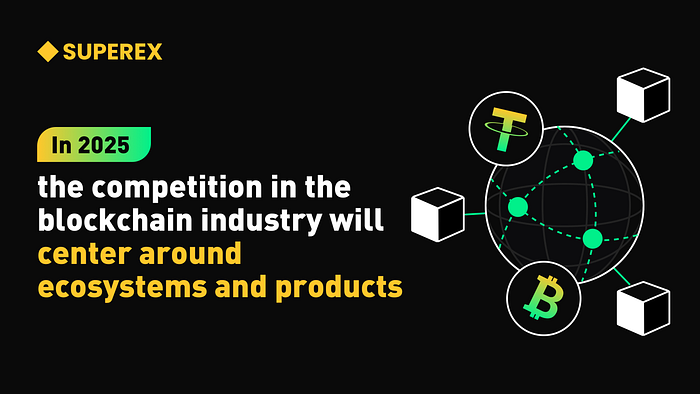2025: the competition in the blockchain industry will center around ecosystems and products

#SuperEx #blockchain #Web3
As we move into 2025, the blockchain industry is entering a transformative phase. What began as a technology-driven field is now evolving into a competition centered on ecosystems and product experiences. This shift signifies not only the maturation of the industry but also the growing focus on meeting user needs through accessible and impactful solutions.
In the early days, blockchain’s growth was driven by breakthroughs in foundational technologies and exploratory use cases. From smart contracts to Layer 2 solutions, sharding, and cross-chain protocols, each innovation brought renewed energy to the space. However, as technological advancements plateau and user demands shift, the industry is increasingly pivoting toward building comprehensive ecosystems and delivering superior product experiences that offer tangible value.
- Click to register SuperEx
- Click to download the SuperEx APP
- Click to enter SuperEx CMC
- Click to enter SuperEx DAO Academy — Space

Ecosystem Competition: A New Era of Strategic Expansion
In 2025, ecosystem development has become the cornerstone of strategies for leading blockchains and platforms. Giants like Ethereum, Solana, and BNB Chain are aggressively expanding their ecosystems to attract developers and users alike.
Firstly, diversity within ecosystems is now a critical competitive factor. Single-function blockchain projects no longer suffice to meet the multifaceted demands of users. Comprehensive ecosystems capable of supporting decentralized finance (DeFi), non-fungible tokens (NFTs), decentralized autonomous organizations (DAOs), and other use cases are proving to be more sustainable and user-centric.
Secondly, collaboration between ecosystems is on the rise. Projects are moving beyond basic cross-chain integrations to deeper partnerships involving data sharing, user experience, and market resources. For instance, Aptos and Sui are aligning their development efforts to optimize scalability and application performance. Additionally, major platforms are working to onboard Web2 users, leveraging traditional internet resources to drive adoption in the blockchain space.
Ecosystem competition is no longer confined to technical innovation; it now extends to capital allocation, user education, and community engagement. Projects capable of synchronizing efforts across these dimensions are emerging as frontrunners in the race for dominance.
Product Competition: A Return to User-Centric Innovation
While ecosystems provide the broader framework for blockchain adoption, products remain the primary touchpoints for users.
In 2025, users demand far more than technical sophistication — they expect seamless interfaces, intuitive functionality, and robust educational resources. This has made product innovation a critical battleground.
Take DeFi as an example. Early DeFi platforms often had complex interfaces and steep learning curves, deterring many potential users. Today, the focus has shifted to user-friendly design, with platforms introducing integrated dashboards, one-click operations, and AI-driven recommendations. These advancements are democratizing access to DeFi, making it more approachable for non-technical users.
The NFT space has also evolved significantly. Users now seek NFTs not just for trading but also for their utility in gaming, art, and social interactions. Platforms that offer end-to-end solutions — marketplaces, wallets, and creative tools — are outperforming competitors with fragmented offerings.
AI is playing an increasingly pivotal role in enhancing product experiences. AI-powered algorithms are optimizing platform security, tailoring personalized recommendations, and streamlining user interactions. For example, AI can analyze trading habits to suggest optimal investment strategies or enable AI-generated content (AIGC) tools to assist creators in the NFT space.
The Future: Ecosystem and Product Synergy
The ultimate winners in the blockchain industry will be those who successfully integrate robust ecosystems with top-tier products. Without strong ecosystems, even the best-designed products will struggle to scale. Conversely, a vibrant ecosystem without user-centric products is unlikely to retain its user base.
Platforms like Cosmos and Polkadot exemplify this synergy. By enabling seamless cross-chain connectivity, they allow users to access a unified product experience across multiple ecosystems. Similarly, Solana’s high-performance blockchain, combined with its expanding ecosystem, has made it a leader in gaming and social applications, creating a self-reinforcing cycle of growth.
Additionally, user education and community building will remain critical. The complexity of blockchain technology and the lack of accessible information continue to deter many potential users. Projects that prioritize clear and engaging educational resources will gain a competitive edge in driving adoption.
Conclusion
In 2025, the blockchain industry’s focus has shifted from isolated technical innovation to holistic ecosystem and product competition. This evolution reflects the industry’s maturation and its alignment with market demands.
The future belongs to those who can build expansive ecosystems while delivering exceptional product experiences. Whether you are a developer, investor, or user, understanding these trends and leveraging them to your advantage will be key to thriving in this dynamic landscape.
Blockchain’s next chapter will be written by visionaries who can turn innovation into impact, creating ecosystems and products that define the future of the industry.







Responses